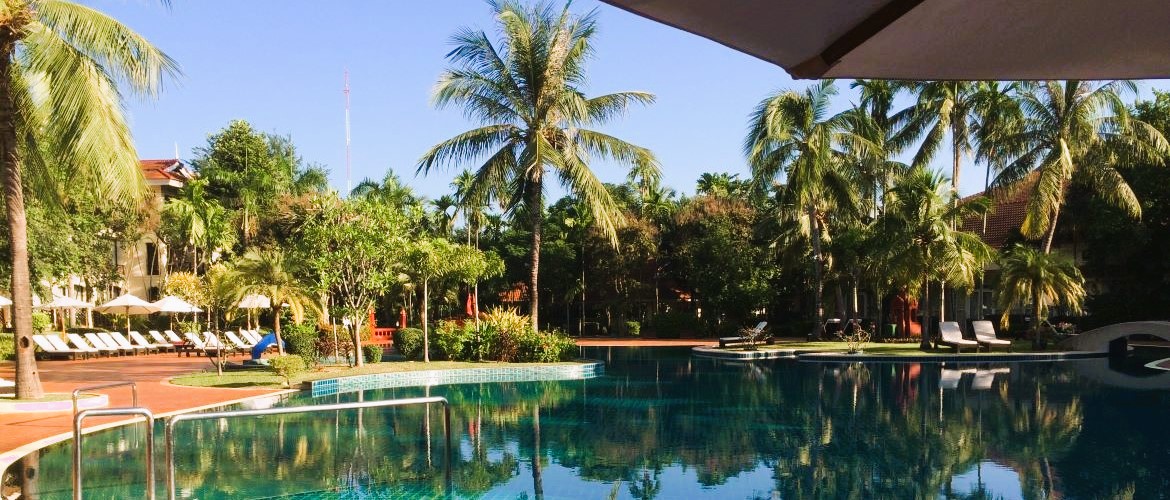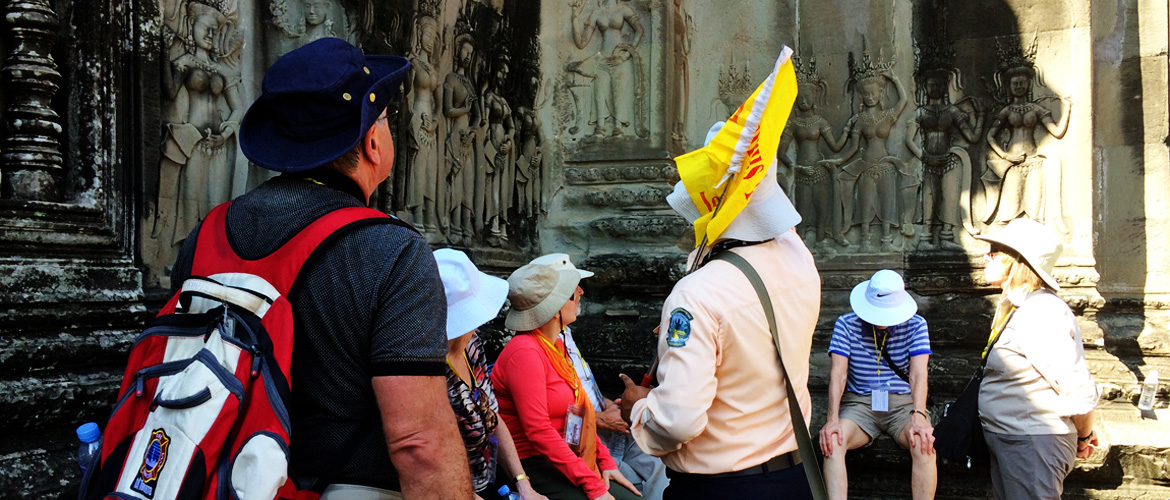Cambodia tours from Canada
If you are looking for Cambodia tours from Canada, you’ve just found the right Canadian tour operator in Laurus Travel. Since 1998, Laurus Travel has been offering premium-quality tours to Asia including Cambodia. Our stellar reputation is your best guarantee for a memorable travel experience. The expert-crafted small-group Cambodia tours from Laurus Travel are competitively priced, but what truly distinguishes Laurus Travel is our commitment to delivering exceptional service. A trip with Laurus Travel is an inspiring and fun-filled learning experience delivered by a team of caring, competent and knowledgeable professionals.
In addition to Canadians, many of our Asia tours have guests from the United States, Australia, the United Kingdom, and some other English-speaking countries. Open-minded travellers view this rich mix of our clientele as one of the factors that make our tours appealing to them.

CAMBODIA TOURS FROM CANADA
Being a small country with limited international air links, Cambodia for Western travellers can only be accessed via its neighouring countries, such as Thailand (Bangkok) and Vietnam (Ho Chi Minh City or Saigon). Travellers from Australia may find it convenient transiting through Singapore. For tourists from North America, going through Hong Kong, Guangzhou, Shanghai, Beijing, Seoul or Tokyo makes good sense.
Normally, when travellers from the West visit Cambodia, they’d add one or two of its neighbouring countries to the itinerary per reason explained above. Below is one such itinerary for your consideration:
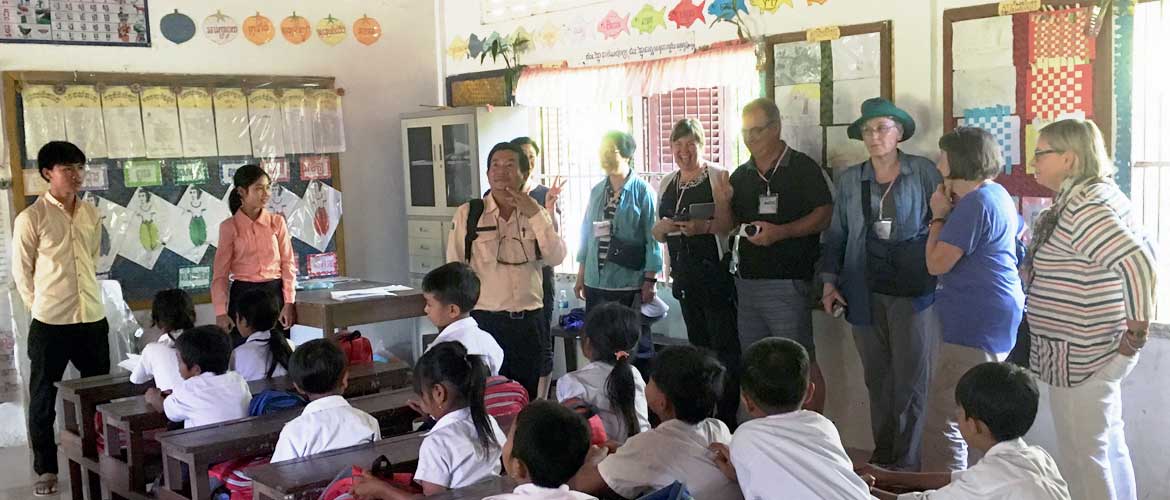
Best of Cambodia plus Saigon & Bangkok (12 days)
Ho Chi Minh City – Phnom Penh – Siem Reap – Bangkok
This luxury small-group tour of Cambodia is a splendid journey of discovery. It combines the Best of Cambodia with Ho Chi Minh City and Bangkok, giving you convenient access to the land of the ancient Khmer civilization.
Important Features
- Small group size – average 15, maximum 20
- Expert guides
- Centrally located luxury hotels
- No sneaky shopping stops
- No annoying long list of “options” to sell
- Quality local and Western cuisines
- Daily breakfast, most lunches and dinners
- Unlimited supply of bottled water during group activities
- Free Wi-Fi in all hotels
- Village visit in Siem Reap
- Canal cruise in Bangkok
Meal Code: B = breakfast / L = lunch / D = dinner
Day 1: Departing Home City
The journey begins with your transpacific flight departing from a city of your choice. You’ll lose a day upon crossing the International Date Line.
Day 2: Arrival in Ho Chi Minh City (Saigon)
Welcome to Ho Chi Minh City! Meet your guide on arrival and transfer to the hotel by private vehicle. The remainder of the day is at leisure. Airport transfer for guests arriving ahead of tour schedule can be arranged on request subject to additional charge.
Day 3: Ho Chi Minh City (B/L/D)
Ho Chi Minh City, HCMS for short, is the largest city in Vietnam, with a population of over 9 million. Formerly named Saigon, it lies 1,160 km (720 miles) south of Hanoi and 605 km (375 miles) southwest of Da Nang.
Ho Chi Minh City began as a small fishing village called Prey Nokor inhabited by Khmer people, who lived here for centuries before the arrival of the Vietnamese. Beginning in the early 17th century, colonization of the area by Vietnamese settlers gradually isolated the Khmers of the Mekong Delta from their brethren in Cambodia proper and resulted in their becoming a minority in the delta. Increasing waves of Vietnamese settlers, which the Cambodian kingdom could not impede because it was weakened by war with Thailand, slowly Vietnamized the area. In time, Prey Nokor became known as Saigon. Prey Nokor was the most important commercial seaport to the Khmers and the loss of the city and the rest of the Mekong Delta cut off Cambodia’s access to the East Sea. Subsequently, the only remaining sea access for the Khmers was southwesterly at the Gulf of Thailand.
Under the name Saigon, the city served as capital of the French colony of Cochinchina from 1862 to 1954 and later of the independent republic of South Vietnam from 1955 to 1975. Saigon was officially renamed Ho Chi Minh City on July 2, 1976.
Our sightseeing morning begins with a stroll along Dong Khoi Street, formerly known as Catinat Street, the main shopping district and heart of the old colonial Saigon. Highlights include such classic European-style landmarks as Hotel De Ville, the old Opera House, Notre Dame Cathedral and the Central Post Office.
We spend the rest of the day exploring the War Remnants Museum and the Reunification Palace. Formerly the presidential palace of the South Vietnamese government, the Reunification Palace was stormed by Viet Cong troops on April 30, 1975, signifying the fall of the Republic of Vietnam commonly known as South Vietnam.
Day 4: Ho Chi Minh City (B/L)
After breakfast we embark on an excursion to Cu Chi Tunnels. Stretching over 200 km, this incredible underground network was an important Viet Cong base during the Vietnam War. The tunnels were used by Viet Cong soldiers as hiding spots during combat as well as communication and supply routes, hospitals, food and weapon caches and living quarters. The tunnels were also the Viet Cong’s base of operations for the Tet Offensive in 1968.
Free afternoon to explore on your own.
Day 5: Ho Chi Minh City – Phnom Penh (B/L/D)
Depending on the type of aircraft in use, our early morning flight to Phnom Penh can take anywhere between 30 to 45 minutes.
Located at the confluence of three rivers (Tonlé Sap, Mekong and Bassac), Phnom Penh is the capital of Cambodia and also the wealthiest and most populous city in the country. Out of a total population of 17 million, 2.2 million of them live in Phnom Penh.
Phnom Penh first became the capital of Cambodia after Ponhea Yat, king of the Khmer Empire, moved the capital from Angkor Thom after it was captured and destroyed by Siam (Thailand). Phnom Penh remained the royal capital for 73 years—from 1432 to 1505 before it was abandoned for 360 years (1505 – 1865) by subsequent kings due to internal fighting between the royal pretenders. Later kings moved the capital several times and established their royal capitals at various locations in Tuol Basan (Srey Santhor), Pursat, Longvek, Lavear Em and Udong. It was not until 1866, under the reign of King Norodom I (1860–1904), the eldest son of King Ang Duong, who ruled on behalf of Siam, that Phnom Penh became the permanent seat of government and capital of Cambodia again.
Beginning in 1870, the French colonialists built this riverside village into a city with hotels, hospitals, schools, prisons, barracks, banks, public works offices, telegraph offices, law courts and so on. In 1872, the first glimpse of a modern city took shape when the colonial administration employed the services of French contractor Le Faucheur to construct the first 300 concrete houses for sale and rental to the Chinese traders. By the 1920s, Phnom Penh was known as the Pearl of Asia, and over the next four decades the city continued to experience rapid growth with the building of railways to Sihanoukville and Pochentong International Airport (now Phnom Penh International Airport).
During the Vietnam War, Cambodia was used as a base by the Viet Cong’s North Vietnamese Army. Thousands of refugees from across the country flooded the capital to escape the fighting between the various factions, thus increasing the population of Phnom Penh to reportedly 3 million. The Khmer Rouge captured the city on April 17, 1975 and started to forcibly evacuate the entire city soon after. All of its residents, including the wealthy and educated, were forced into the countryside to do manual labour so that they could become “new people” according to the Khmer Rouge. Tuol Sleng High School was turned into a prison camp known as S-21, where people were detained and tortured. Pol Pot sought a return to an agrarian economy and therefore killed many people perceived as lazy or political enemies. The Khmer Rouge was driven out of Phnom Penh by the Vietnamese in 1979, and people began to return to the city. Vietnam is historically a state with which Cambodia has had many conflicts; therefore, this liberation was and is viewed with mixed feelings by the Cambodians. A period of reconstruction began, spurred by the continuing stability of government, new foreign investment and international aid.
Our sightseeing today includes the Royal Palace Complex and the National Museum.
Day 6: Phnom Penh (B/L)
Today we visit Tuol Sleng Genocide Museum and Choeung Ek Killing Fields. These sites may be too much for the visitor to stomach, but they embody an important period in the country’s history no matter how repugnant that period is in our common memory.
Tuol Sleng Genocide Museum is on the same site of the high school turned prison known as S-21. Inside, Khmer Rouge’s torture devices and photos of their victims are on display. If you have read about Tuol Sleng and feel the gruesome scenes may be too disturbing, you may instead opt for a walk through the neighbourhood outside the former high school.
Choeung Ek (The Killing Fields) is 15 kilometers from the city centre. It was one of the mass grave sites of the victims of the Khmer Rouge regime.
Day 7: Phnom Penh – Siem Reap (B/L/D)
The morning flight to Siem Reap takes 40 minutes. After a light lunch, we visit the Angkor National Museum and Angkor Wat.
The archaeological museum is dedicated to the collection, preservation and presentation of Angkorian artifacts, also to provide information and education about art and culture of Khmer civilization, with collections mainly dated from Khmer Empire’s Angkor period circa 9th to 14th-century. Most of the artifacts are discovered in and around the Angkor archaeological sites nearby. Opened on November 12, 2007, the Angkor National Museum covers the golden era of the Khmer Empire in eight galleries. The museum visit at the beginning of the stay in Siem Reap is designed to better prepare tour participants for what to see next.
Angkor Wat, the modern name for the temple complex, means “Temple City” or “City of Temples” in Khmer. Angkor, meaning “city” or “capital city”, is a vernacular form of the word nokor, which comes from the Sanskrit word nagara. Wat is the Khmer word for “temple grounds”. Angkor Wat was a Hindu temple complex that was later used for Buddhism. It is the largest religious monument in the world. The temple was built by the Khmer King Suryavarman II in the early 12th century in Yaśodharapura (present-day Angkor), the capital of the Khmer Empire, as his state temple and eventual mausoleum. Breaking from the Shaiva tradition of previous kings, Angkor Wat was instead dedicated to Vishnu. As the best-preserved temple at the site, it is the only one to have remained a significant religious center since its foundation. The temple is at the top of the high classical style of Khmer architecture and has become a symbol of Cambodia, appearing on its national flag and the back of the 20,000-riel banknote.
Angkor Wat combines two basic plans of Khmer temple architecture: the temple-mountain and the later galleried temple, based on early Dravidian architecture, with key features such as the Jagati. It is designed to represent Mount Meru, home of the devas in Hindu mythology: within a moat and an outer wall of 3.6 kilometres long are three rectangular galleries, each raised above the next. At the centre of the temple stands a quincunx of towers. Unlike most Angkorian temples, Angkor Wat is oriented to the west; scholars are divided as to the significance of this. The temple is admired for the grandeur and harmony of the architecture, its extensive bas-reliefs, and for the numerous devatas adorning its walls.
Day 8: Siem Reap (B/L)
Visit Angkor Thom and Ta Prohm in the morning and have the afternoon at leisure after lunch.
Angkor Thom (literally: great city) was established in the late 12th century by King Jayavarman VII as the capital of the Khmer Empire. It covers an area of 9 km² and includes several monuments from earlier eras as well as those established by Jayavarman and his successors. One inscription found in the city refers to Jayavarman as the groom and the city as his bride. Angkor Thom was the last and most enduring capital city of the Khmer empire. At the centre of the city is Jayavarman’s state temple, the Bayon, with the other major sites clustered around the Victory Square immediately to the north.
Ta Prohm, originally called Rajavihara, is the modern name of the temple built in the Bayon style largely in the late 12th and early 13th centuries. Located approximately one kilometre east of Angkor Thom and on the southern edge of the East Baray, it was founded by the Khmer King Jayavarman VII as a Mahayana Buddhist monastery and university. Unlike most Angkorian temples, Ta Prohm has been left in much the same condition in which it was found. The photogenic and atmospheric combination of trees growing out of the ruins and the jungle surroundings has made it one of Angkor’s most popular temples with visitors.
Day 9: Siem Reap (B/L)
After breakfast, we drive 25 km to Banteay Srei (Citadel of Women), a 10th-century temple dedicated to the Hindu god Shiva. The buildings themselves are miniature in scale but the stone carvings are magnificent. On the way back to the hotel, we stop by a village for a better look at the local rural life.
Day 10: Siem Reap – Bangkok (B/L)
Our morning flight to Bangkok takes 50 minutes.
Located in Chao Phraya River delta, Bangkok is the capital and the most populous city of Thailand, with a population of 10 million within the city proper or just over 15% of the country’s total.
Bangkok traces its roots to a small trading post during the Ayutthaya Kingdom in the 15th century, which eventually grew in size and became the site of two capital cities: Thonburi in 1768 and Rattanakosin in 1782. Bangkok was at the heart of Siam’s (as Thailand used to be known) modernization during the later 19th century, as the country faced pressure from the West. The city was the centre stage of Thailand’s political struggles throughout the 20th century, as the country abolished absolute monarchy, adopted constitutional rule and underwent numerous coups and uprisings. The city grew rapidly during the 1960s through the 1980s.
We begin our afternoon sightseeing at Wat Arun, a Buddhist temple on the Chao Phraya River. The temple derives its name from the Hindu god Aruna, often personified as the radiations of the rising sun. Wat Arun is among the best-known of Thailand’s landmarks.
We wrap up the day with a relaxing cruise aboard a long-tail boat that plies Chao Phraya River and the canals of Thonburi. This is a perfect way to watch the skyline of Bangkok and to observe the local life.
Day 11: Bangkok (B/L/D)
Our morning sightseeing begins at the royal Grand Palace. Established in 1782, the palace was dramatically expanded throughout successive reigns. The king and his royal government were based on the grounds of the palace until 1925.
We then proceed to the National Museum, which is the largest museum in Southeast Asia and features exhibits of Thai art and history.
After lunch we spend the rest of the day exploring on our own.
Day 12: Bangkok – Home City (B)
The tour ends today. Transfer to the airport for your return flight. If you choose to extend your stay, taxi fare to get to the airport should cost around $12 US. Transfer to the airport by Airport Rail Link is much cheaper – $2 per person. Arrive home the same day after crossing the International Date Line.
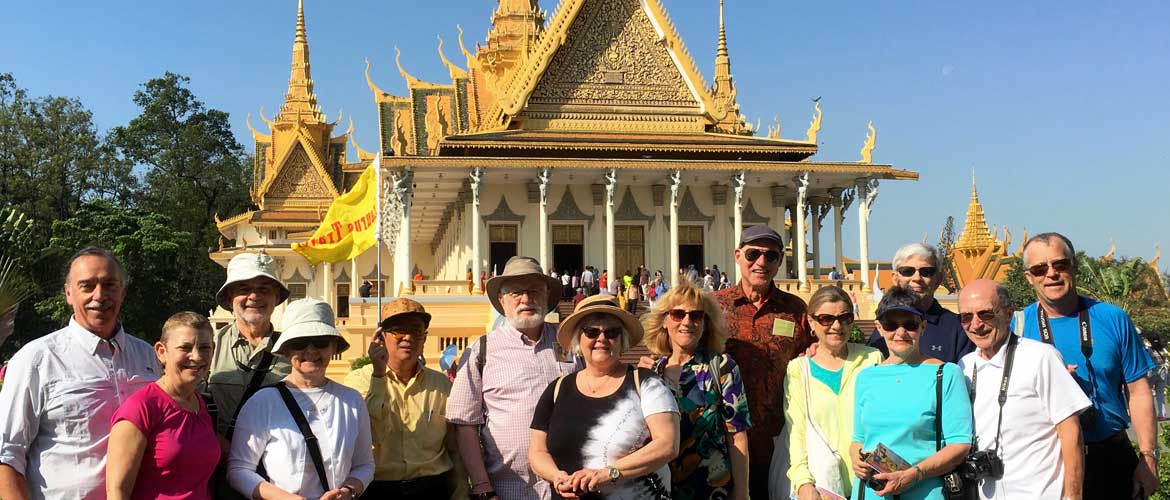
| City | Nights | Hotel | Category |
| Ho Chi Minh City | 3 | Renaissance Riverside | luxury |
| Phnom Penh | 2 | La Rose Suites | luxury |
| Siem Reap | 3 | Victoria Angkor Resort | luxury |
| Bangkok | 2 | Sofitel Sukhumvit | luxury |
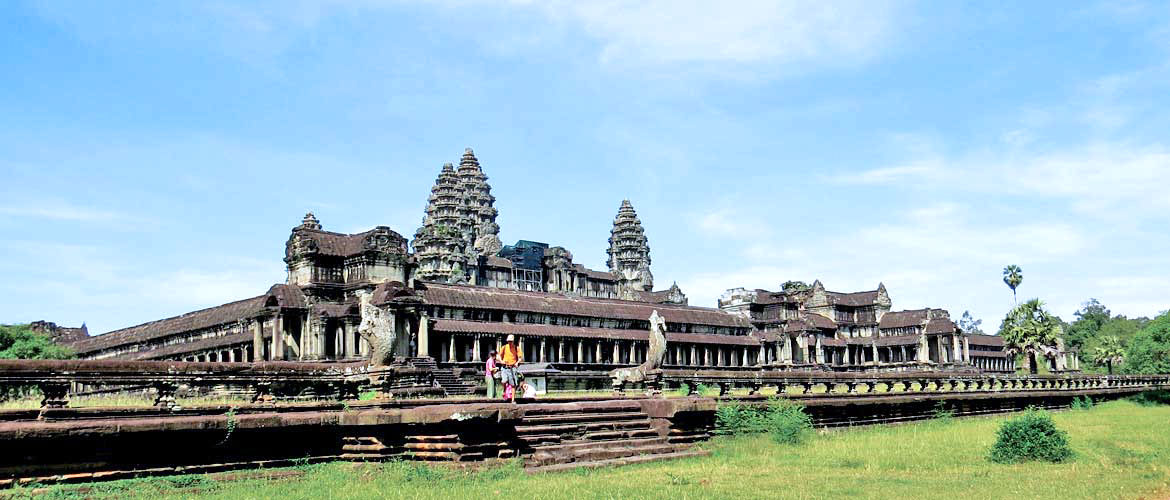
Passport
A passport with at least three (3) blank visa pages and six (6) months validity at the end of the tour is required.
Visa
Thailand does not require visa for stays less than 30 days. Vietnamese and Cambodian e-visa can be easily obtained online and we advise you to apply within 30 days of travel. We are ready to assist you with your application. If you do it yourself, deal with the appropriate authorities directly and avoid any middleman – some of them use domain names ending with .govt.vn or .org to fool the public.
Vietnam Tourist e-Visa – US$25
https://evisa.xuatnhapcanh.gov.vn/
https://www.xuatnhapcanh.gov.vn
Cambodia Tourist e-Visa – US$36
https://www.evisa.gov.kh/
Immunization
Visitors may be asked to show proof of vaccinations against COVID-19 prior to or on arrival. COVID testing prior to arrival is no longer required.
We are not aware of any other inoculation requirements and we suggest you visit the websites of your national government’s disease control centre and pertinent embassies in your country for the latest. We recommend all of our guests to be vaccinated against hepatitis A.
Tips on Staying Healthy
Do not drink from the tap when you travel. Ask for bottled or boiled water when eating in restaurants. When buying bottled water from street vendors, especially at tourist sites, make sure the cap is properly sealed because some vendors may be selling tap water in recycled bottles.
Try to avoid uncooked food. Raw food, even clean, may still cause stomach upset or diarrhoea.
Always carry a roll of toilet paper and a bottle of hand sanitizer containing more than 60% of alcohol, no matter where you go.
Always have an N95 type of facemask ready. Passengers sitting next to you may be sick and cough loud but wear nothing to cover their mouth. This was a big problem before the pandemic that may return soon.
Banknotes in general are filthy and carry all kinds of germs. Minimize your contact with local banknotes and coins by keeping them in a plastic bag and sanitize your hands every time you touch them. Use plastic for payment as much as possible.
Currency & Credit Card
Vietnam currency: Dông (VND)
Cambodia currency: Riel (KHR)
Thai currency: Baht (THB)
Please keep your inventory of local currencies to the minimum. Your tour fare covers all the expensive items already. You only need some local cash, which can be easily obtained as you go, for souvenirs and meals not included in the tour price.
Consider using a credit card for transactions over $20. Major credit cards such as Visa and MasterCard are widely accepted throughout Southeast Asia. Street vendors in Vietnam and Cambodia prefer U.S. dollars to their own currency but you should exercise caution if you want to play along. Merchants in more prosperous Thailand only accept their own currency if you pay by cash.
Travel Insurance – When to Buy
We will save your deposit as credit if you cancel at any time and for any reason. The transferrable credit has no expiration date. Therefore, it may be unnecessary to pay $30 to $50 on cancellation insurance for your deposit.
However, you should definitely consider purchasing trip cancellation & emergency medical insurance when your balance is due. If you don’t have proper coverage, the loss can be devastating if you were forced to cancel close to departure date or ran into a serious medical emergency during the trip. Please ask us for insurance quotes when your balance is due.
